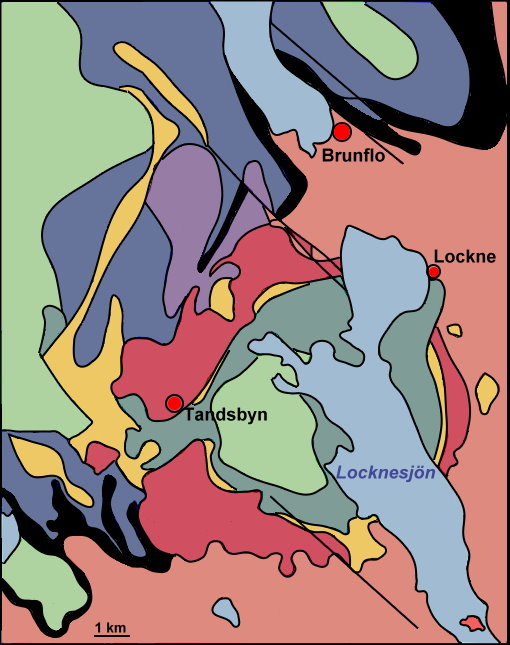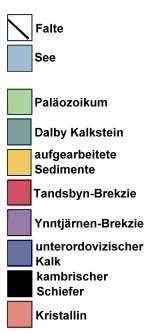Schweden - Impaktite - Lockne
|
Der Lockne-Impakt südlich von Östersund (E Storsjön) in Jämtland erfolgte im Mittleren Ordovizium (458 Mio. Jahre) in einem kontinentalnahen Schelfgebiet. Er liegt im Grenzgebiet zwischen dem svecofennischen kristallinen Untergrund (Pilgrimstad-Granit, ältere Granitoide, Meta-Vulkanite) und dem Kaledonischen Deckgebirge (Quarzite, Grauwacken, Kalksteine u. a.). |
 |
||
 |
|||
|
Kartenskizze
(vereinfacht) nach Angaben in "Palaeozoic impact craters"
(Exkursionsbericht IGC 2008), S. 26 |
|||
| Die Lockne-Impaktstruktur besteht aus einem inneren Krater (ca. 6 km ø) und einem äußeren Ring (stellenweise bis 12 km vom Zentrum nachweisbar). Kennzeichnend für den Lockne-Impakt sind grobklastische monomikte Brekzien. | |||
|
Marine Impakte unterscheiden sich in mehrfacher Hinsicht von
terrestrischen Impakten. Eine Besonderheit besteht in der
Ausbildung von "resurge gullies", d. h. Rinnenstrukturen, die
durch die erodierende Gewalt des in den Krater zurückströmenden
Wassers entstehen. Sie durchschneiden radial den Kraterrand. Im
Lockne-Impakt wurden vier Resurge Gullies identifiziert. Das in einer gewaltigen Flut den Krater erneut füllende Wasser führt "fallback-ejecta" (Rückfall-Gesteine) und zertrümmerte Gesteine vom umgebenden Meeresboden ("target rock") mit. Da das Untergrundgestein des Lockne-Impaktes über dem kristallinen Grundgebirge weitgehend aus einer sedimentären Sequenz von ca. 30 m Schwarzschiefer und ca. 50 m Kalkstein bestand, bilden außer kristallinen vor allem solche Gesteinstrümmer die basalen Lockne-Brekzien. Neben den grobklastischen Brekzien treten in den Gullies feinkörnige Resurge-Ablagerungsgesteine auf. Sie bestehen ebenfalls aus kristallinem und sedimentärem (marinem) Auswurfmaterial (Klasten) sowie Schmelz-Relikten, allerdings meist in arenitischen bis schluffigen Korngrößen. Im Kontext des Lockne-Impakts werden sie als Loftarstone bezeichnet. |
|||
|
Zu empfehlen ist u. a. der Aufsatz: "Water-blow and resurge breccias
at the Lockne marine-target impact structure" (Lindström, Sturkell, Ormö 2007 in: Special Papers 437 [Geological society of America] 2008, S. 43-54). Zitat des Abstracts: "The Ordovician (early Sandbian) Lockne impact crater in central Sweden formed in a sea at least 500 m deep. The structure and impact stratigraphy are sufficiently well preserved to permit detailed analysis of the cratering process. The target seabed consisted of a partly lithified, 75–80-m-thick sediment cover resting on continental crystalline basement. An over 7-km-wide inner crater formed in the basement. The surrounding sediment cover was almost completely removed within about 2 km from the rim of the inner crater. At 2.5–8.5 km from the rim, the thickness of preserved preimpact sediment increases with the distance to the inner crater. The top of the preserved sediment is mostly limestone breccia. Brecciation was probably driven by extremely forceful flow of water that was charged with sediment to the limit of its carrying capacity, and therefore stirred deeper than it would erode. The resulting lithology, for which we suggest the term “water-blow breccia,” is monomictic, with all clasts deriving from the underlying parent rock. Great volumes of crystalline ejecta were emplaced during and immediately after water-blow brecciation. The resurge, connected with the subsequent collapse of the water crater, deposited a mixed breccia of transported clasts that includes eroded limestone of various local provenances, as well as crystalline ejecta. The resurge breccia occurs extensively in the region, even outside the area characterized by occurrences of water-blow breccia. Its thickness and clast sizes decrease away from the crater. " http://specialpapers.gsapubs.org/content/437/43.abstract |
|||
|
|
|||
| Gesteinsproben aus dem Lockne-Gebiet: | |||
|
|
|
|
|
| Lockne-Brekzie | Lockne-Brekzie | Loftarstone |
| weiterführende Literatur (Auswahl): Lindström M. 1994: Geological map of the Lockne Impact Crater.; Berggrundskarta över Lockne nedslagskrater, 1:50000 Lindström M. et al. 1996: The marine impact crater at Lockne, central Sweden. GFF 118, 4 S. 193-206 Lindström M. Dalwigk Ilka Von 2002: Geological Guide to the Lockne & Dellen Impact Structure (Stockholm Contributions in Geology) ISBN-10: 9122019766 Lindström M. et al 2005: The Lockne Crater: Revision and Reassessment of Structure and Stratigraphy in: C. Koeberl/H. Henkel (Hrsg.) Impact Tectonics. Springer Verlag Heidelberg S. 357-389 Lindström M. et al. 2007: Water-blow and resurge breccias at the Lockne marine-target impact structure. (Lindström, Sturkell, Ormö 2007 in: Special Papers 437 [Geological society of America] 2008, S. 43-54). Sjöqvist A.S.L. et al. 2012: Carbonate melt fragments in resurge deposits from the Lockne impact structure, Sweden. [43rd Lunar and Planetary Science Conference 2012, The Woodlands, Texas] Sturkell E.F.F. 1998: The marine Lockne impact structure, Jämtland Sweden: a review, Geologische Rundschau, International Journal of Earth Sciences 87, 3 S. 253-267 |
|
| Links: http://www.33igc.org/fileshare/filArkivRoot/coco/FieldGuides/No%2010%20Palaeozoic%20Impact%20Craters.pdf http://www.panoramio.com/photo/4780064 |
|
|
|
zur Übersichtskarte Härjedalen (Lokalität 15) |
